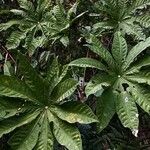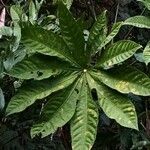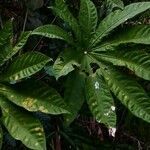Trees, evergreen, to 8 m tall. Trunk to ca. 15 cm d.b.h.; branches prickly, farinose stellate pubescent. Leaves simple; petiole often prickly, 30-70(-90) cm; stipules united into a 2-lobed sheath; blade large, 60-90 cm wide, leathery, both surfaces glabrous or with scattered stellate hairs, lateral veins distinct on both surfaces, deeply 5-9-lobed; lobes narrowly ovate-lanceolate, margin serrate, apex acuminate. Inflorescence a panicle of umbels, ca. 45 cm, densely farinose stellate pubescent when young, glabrescent; peduncles 4-17 cm; umbels 4-5 cm in diam., 25-45-flowered; pedicels 1.5-2 cm. Calyx rim 1-2 mm, farinose stellate pubescent. Stamens 7-12. Ovary 7-12-carpellate. Fruit subglobose to compressed-globose, 1-1.8 cm in diam., smooth or ribbed; styles united, conic, 2-4 mm, stout, persistent. Fl. Oct, fr. May-Jul.
More
A shrub or small tree. It grows to 3-9 m high. The branches are armed with short, sharp prickles which curve inwards. The young shoots have rusty hairs. The leaves are stalked. The leaves are 25-33 cm long. They are round and deeply divided like fingers on a hand. The lobes taper to the tip. There are teeth along the edge. Leaves are leathery. The flowers are in white heads which are flat topped. The fruit is fleshy. They are crowded together.
A tropical plant. It is native from India to S China. In Nepal plants grow to about 2500 m altitude. In Thailand they grow to 1,500 m altitude. In Borneo it grows between 600-2,000 m above sea level. It is often near streams and in wet places. It suits hardiness zones 10-12. In Yunnan.
More
An understorey tree in moist, mixed forests on mountain slopes; at elevations from 600-2,000 metres.




